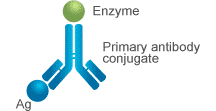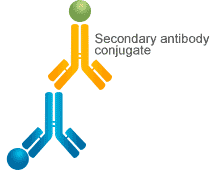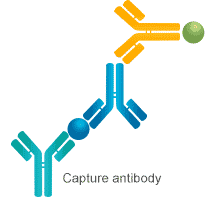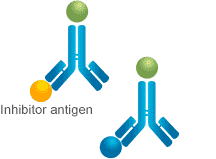ELISA, short for enzyme-linked immunosorbent assay, is a very mature method for the detection of various targets. One advantage of ELISA is that it's quick and simple to carry out, so it is often used for both diagnostic and research purposes.
As its name implies, ELISA involves the use of enzymes and the specific binding of antibody and antigen. According to how it works, ELISA can be divided into four major types: direct, indirect, sandwich, and competitive. Let's see them one by one.
Direct ELISA
In direct ELISA, only an enzyme-labeled primary antibody is used, meaning that secondary antibodies are not needed. The enzyme-labeled primary antibody "directly" binds to the target (antigen) that is immobilized to the plate (solid surface). Next, the enzyme linked to the primary antibody reacts with its substrate to produce a visible signal that can be measured. In this way, the antigen of interest is detected.
Indirect ELISA
In indirect ELISA, both a primary antibody and a secondary antibody are used. But in this case, the primary antibody is not labeled with an enzyme. Instead, the secondary antibody is labeled with an enzyme.
The primary antibody binds to the antigen immobilized to the plate, and then the enzyme-labeled secondary antibody binds to the primary antibody. Finally, the enzyme linked to the secondary antibody reacts with its substrate to produce a visible signal that can be measured.
Sandwich ELISA
In direct and indirect ELISA, it is the antigen that is immobilized to the plate. In sandwich ELISA, however, it is the antibody that is immobilized to the plate, and this antibody is called capture antibody. In addition to capture antibody, sandwich ELISA also involves the use of detection antibodies, which generally include the unlabeled primary detection antibody and the enzyme-labeled secondary detection antibody.
Firstly, the antigen of interest binds to the capture antibody immobilized to the plate. Secondly, the primary detection antibody binds to the antigen. Thirdly, the secondary detection antibody binds to the primary detection antibody, and then the enzyme reacts with its substrate to produce a visible signal that can be measured.
More details about direct ELISA protocol, indirect ELISA protocol, and sandwich ELISA protocol, please check it here.
Competitive ELISA
Compared with the three ELISA types above, competitive ELISA is relatively complex because it involves the use of inhibitor antigen, so competitive ELISA is also known as inhibition ELISA. In fact, each of the three formats, direct, indirect, and sandwich, can be adapted to the competitive format. In competitive ELISA, the inhibitor antigen and the antigen of interest compete for binding to the primary antibody. Here is a procedure of competitive ELISA:
Firstly, the unlabeled primary antibody is incubated with the sample containing the antigen of interest, leading to the formation of antigen-antibody complex (Ag-Ab). In this step, the antibody is excessive compared with the antigen, so there are free antibodies left.
Secondly, the Ag-Ab mixture is added to the plate coated with inhibitor antigen that can also bind to the primary antibody. The free primary antibody in the mixture binds to the inhibitor antigen on the plate, while the Ag-Ab complexes in the mixture do not and are therefore washed off.
Thirdly, the enzyme-labeled secondary antibody is added to the plate and binds to the primary antibody bound to the inhibitor antigen on the plate.
Finally, a substrate is added to react with the enzyme and emit a visible signal for detection.
Through this procedure, you may find that the final signal is inversely associated with the amount of the antigen of interest in the sample, meaning that the more antigen in the sample, the weaker the final signal. This is because primary antibodies bound to sample antigen will be washed off, while free primary antibodies left will be captured by inhibitor antigen immobilized to the plate and be measured by an enzymatic reaction.
Competitive ELISA described here is based on antibody capture, in which the plate is coated with antigen. There is another type of competitive ELISA that is based on antigen capture, in which the plate is coated with unlabeled antibody. Furthermore, competitive ELISA generally uses a labeled antibody for detection, but sometimes it uses labeled antigen instead of a labeled antibody.
Comparison of direct, indirect, sandwich, and competitive ELISA
Now we know how the four most common types of ELISA work, but how to choose the right type for your experiment? To find the answer, you need to understand the advantages and disadvantages of each ELISA type.
Table 1. Advantages and disadvantages of each ELISA type
|
Advantages
|
Disadvantages
|
|
Direct ELISA
|
-
Simple protocol, time-saving, and reagents-saving.
-
No cross-reactivity from secondary antibody.
|
-
High background.
-
No signal amplification, since only a primary antibody is used and a secondary antibody is not needed.
-
Low flexibility, since the primary antibody must be labeled.
|
|
Indirect ELISA
|
-
Signal amplification, since one or more secondary antibodies can be used to bind to the primary antibody.
-
High flexibility, since the same secondary antibody can be used for various primary antibodies.
|
-
Complex protocol compared with direct ELISA.
-
Cross-reactivity from secondary antibody.
|
|
Sandwich ELISA
|
-
High flexibility.
-
High sensitivity.
-
High specificity, since different antibodies bind to the same antigen for detection.
|
-
The antigen of interest must be large enough so that two different antibodies can bind to it at different epitopes.
-
It's sometimes difficult to find two different antibodies that recognize different epitopes on the antigen of interest and cooperate well in a sandwich format.
|
|
Competitive ELISA
|
-
High flexibility.
-
High sensitivity.
-
Best for the detection of small antigens, even when they are present in low concentrations.
|
-
Relatively complex protocol.
-
Needs the use of inhibitor antigen.
|
Others
In addition to the four most common ELISA types above, there are other ELISA types that help meet the various demands of experiments. Here are two examples:
ELISPOT
ELISPOT, short for enzyme-linked immunospot assay, is used to measure the frequency of protein-secreting cells at the single-cell level. The technique that ELISPOT uses is very similar to that of sandwich ELISA.
In-cell ELISA
In-cell ELISA is used to measure the levels of the target protein within cells that are fixed on the plate. It also involves the use of the technique used by sandwich ELISA.
First, cells are fixed to the plate and are permeablized. Next, a primary antibody is added to react with the target protein within the cells. Finally, a labeled secondary antibody is added to react with the primary antibody. In this way, the target protein within cells is detected.
Quantitative and qualitative ELISA
On the basis of whether ELISA can quantify the level of the target molecule, ELISA can be divided into two types, qualitative and quantitative. Qualitative ELISA provides a simple positive or negative result for a sample, while quantitative ELISA reflects the concentration of the target molecule in a sample via a standard curve. So, if you want to quantify the target molecule level, choose quantitative ELISA.
ELISA is used for both diagnostic and research purposes. Diseases detected by ELISA include HIV, HBV, influenza, Hemolytic Anemia, Lyme disease, food allergy, and so on. Currently, there is a large number of ELISA kits supplied by manufacturers worldwide. But some ELISA kits are only used in research and cannot be used in diagnosis. Cusabio is one of the manufacturers offering ELISA kits for research use. How to choose the right ELISA kit for your research? Please read this article: 11 tips for choosing your right ELISA kit.
You can also develop your own ELISA if there are no ELISA kits commercially available for your research. During ELISA development, the antibody selection is of critical importance. Many factors such as the affinity, specificity, and titer of the antibody must be taken into consideration.
Besides that, here are some common problems of ELISA for you, and we hope that can give you help.
CUSABIO team. Four Types of ELISA. https://www.cusabio.com/c-20659.html








Comments
Leave a Comment